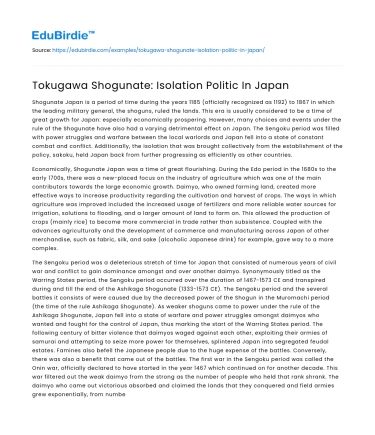Shogunate Japan is a period of time during the years 1185 (officially recognized as 1192) to 1867 in which the leading military general, the shoguns, ruled the lands. This era is usually considered to be a time of great growth for Japan: especially economically prospering. However, many choices and events under the rule of the Shogunate have also had a varying detrimental effect on Japan. The Sengoku period was filled with power struggles and warfare between the local warlords and Japan fell into a state of constant combat and conflict. Additionally, the isolation that was brought collectively from the establishment of the policy, sakoku, held Japan back from further progressing as efficiently as other countries.
Economically, Shogunate Japan was a time of great flourishing. During the Edo period in the 1680s to the early 1700s, there was a new-placed focus on the industry of agriculture which was one of the main contributors towards the large economic growth. Daimyo, who owned farming land, created more effective ways to increase productivity regarding the cultivation and harvest of crops. The ways in which agriculture was improved included the increased usage of fertilizers and more reliable water sources for irrigation, solutions to flooding, and a larger amount of land to farm on. This allowed the production of crops (mainly rice) to become more commercial in trade rather than subsistence. Coupled with the advances agriculturally and the development of commerce and manufacturing across Japan of other merchandise, such as fabric, silk, and sake (alcoholic Japanese drink) for example, gave way to a more complex.
Save your time!
We can take care of your essay
- Proper editing and formatting
- Free revision, title page, and bibliography
- Flexible prices and money-back guarantee
The Sengoku period was a deleterious stretch of time for Japan that consisted of numerous years of civil war and conflict to gain dominance amongst and over another daimyo. Synonymously titled as the Warring States period, the Sengoku period occurred over the duration of 1467-1573 CE and transpired during and till the end of the Ashikaga Shogunate (1333-1573 CE). The Sengoku period and the several battles it consists of were caused due by the decreased power of the Shogun in the Muromachi period (the time of the rule Ashikaga Shogunate). As weaker shoguns came to power under the rule of the Ashikaga Shogunate, Japan fell into a state of warfare and power struggles amongst daimyos who wanted and fought for the control of Japan, thus marking the start of the Warring States period. The following century of bitter violence that daimyos waged against each other, exploiting their armies of samurai and attempting to seize more power for themselves, splintered Japan into segregated feudal estates. Famines also befell the Japanese people due to the huge expense of the battles. Conversely, there was also a benefit that came out of the battles. The first war in the Sengoku period was called the Onin war, officially declared to have started in the year 1467 which continued on for another decade. This war filtered out the weak daimyo from the strong as the number of people who held that rank shrank. The daimyo who came out victorious absorbed and claimed the lands that they conquered and field armies grew exponentially, from numbers which were only hundreds to tens of thousands. This allowed the opportunity for more complex army formation dynamics and configurations. However, it is indisputable that during the Warring States period famines occurred and people were at constant threat of battles, war, and pillage; all of which were harmful to Japan as a country.
The advances for Japan were slackened and stunted in comparison to the rest of the world, mainly due to the isolation that came as a consequence of sakoku. The shogun, Tokugawa Iemitsu established sakoku as a policy in the year 1633. It forbade any foreigners to have the ability to enter Japan’s lands, outlawing western trade completely. The Japanese were also prohibited from leaving the country, lest be faced with a sentence to death. Tokugawa Iemitsu considered foreign influence to be jeopardy to his rule and authority and drew harsh demarcations surrounding Japan to isolate it from the rest of the world. The shogun enforced this policy as a means to further consolidate his supremacy over Japan. It prevented any trade from anywhere than inside Japan, with the exception of very restricted contact with China and the Netherlands. As a consequence of this, Japan fell behind and progressed slower on an international scale due to the ostracization of global interaction. The difference between Japan and western technology is clearly emphasized when the Americans first came to Japan on the 8th of July, 1853, depicted in an artist’s interpretation of the event on the side. There is a stark contrast between the small wooden boats that the Japanese sailed in comparison to the gargantuan, black steamships that Commodore Matthew Perry commanded. Upon the arrival of the ships, the Japanese were so shocked by the sheer size and weaponry on them that they called the ships, ‘giant dragons, puffing smoke’, highlighting Japan’s ignorance rooted in being cut off from the outside world. Sakoku is also the cause of the Tokugawa Shogunate’s downfall, when Overall, the sakoku policy was detrimental to Japan's growth as a country.






 Stuck on your essay?
Stuck on your essay?

